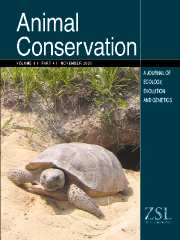Crossref Citations
This article has been cited by the following publications. This list is generated based on data provided by
Crossref.
Larivière, Serge
and
Ferguson, Steven H.
2003.
EVOLUTION OF INDUCED OVULATION IN NORTH AMERICAN CARNIVORES.
Journal of Mammalogy,
Vol. 84,
Issue. 3,
p.
937.
Blomberg, Simon P.
Garland, Theodore
and
Ives, Anthony R.
2003.
TESTING FOR PHYLOGENETIC SIGNAL IN COMPARATIVE DATA: BEHAVIORAL TRAITS ARE MORE LABILE.
Evolution,
Vol. 57,
Issue. 4,
p.
717.
Caro, T.M
and
Stoner, C.J
2003.
The potential for interspecific competition among African carnivores.
Biological Conservation,
Vol. 110,
Issue. 1,
p.
67.
H. Ferguson, Steven
and
Larivière, Serge
2004.
Are long penis bones an adaption to high latitude snowy environments?.
Oikos,
Vol. 105,
Issue. 2,
p.
255.
Ferguson, Steven
and
Lariviére, Serge
2005.
Martens and Fishers (Martes) in Human-Altered Environments.
p.
3.
Zielinski, William J.
Truex, Richard L.
Schlexer, Fredrick V.
Campbell, Lori A.
and
Carroll, Carlos
2005.
Historical and contemporary distributions of carnivores in forests of the Sierra Nevada, California, USA.
Journal of Biogeography,
Vol. 32,
Issue. 8,
p.
1385.
Rezende, Enrico L.
Kelly, Scott A.
Gomes, Fernando R.
Chappell, Mark A.
and
Garland Jr., Theodore
2006.
Effects of Size, Sex, and Voluntary Running Speeds on Costs of Locomotion in Lines of Laboratory Mice Selectively Bred for High Wheel‐Running Activity.
Physiological and Biochemical Zoology,
Vol. 79,
Issue. 1,
p.
83.
H. Ferguson, Steven
W. Higdon, Jeff
and
Larivière, Serge
2006.
Does seasonality explain the evolution and maintenance of delayed implantation in the family Mustelidae (Mammalia: Carnivora)?.
Oikos,
Vol. 114,
Issue. 2,
p.
249.
Ferguson, Steven H.
and
Higdon, Jeff W.
2006.
How seals divide up the world: environment, life history, and conservation.
Oecologia,
Vol. 150,
Issue. 2,
p.
318.
Perez, M.
Li, B.
Tillier, A.
Cruaud, A.
and
Veron, G.
2006.
Systematic relationships of the bushy-tailed and black-footed mongooses (genus Bdeogale, Herpestidae, Carnivora) based on molecular, chromosomal and morphological evidence.
Journal of Zoological Systematics and Evolutionary Research,
Vol. 44,
Issue. 3,
p.
251.
Loyola, Rafael D.
De Oliveira, Guilherme
Diniz‐Filho, José Alexandre Felizola
and
Lewinsohn, Thomas M.
2008.
Conservation of Neotropical carnivores under different prioritization scenarios: mapping species traits to minimize conservation conflicts.
Diversity and Distributions,
Vol. 14,
Issue. 6,
p.
949.
Valenzuela-Galván, David
Arita, Hector T.
and
Macdonald, David W.
2008.
Conservation priorities for carnivores considering protected natural areas and human population density.
Biodiversity and Conservation,
Vol. 17,
Issue. 3,
p.
539.
Sergio, Fabrizio
Caro, Tim
Brown, Danielle
Clucas, Barbara
Hunter, Jennifer
Ketchum, James
McHugh, Katherine
and
Hiraldo, Fernando
2008.
Top Predators as Conservation Tools: Ecological Rationale, Assumptions, and Efficacy.
Annual Review of Ecology, Evolution, and Systematics,
Vol. 39,
Issue. 1,
p.
1.
Robbins, Martha M
Gray, Maryke
Kagoda, Edwin
and
Robbins, Andrew M
2009.
Population dynamics of the Bwindi mountain gorillas.
Biological Conservation,
Vol. 142,
Issue. 12,
p.
2886.
Macdonald, David W.
Newman, Christopher
Nouvellet, Pierre M.
and
Buesching, Christina D.
2009.
An Analysis of Eurasian Badger (Meles meles) Population Dynamics: Implications for Regulatory Mechanisms.
Journal of Mammalogy,
Vol. 90,
Issue. 6,
p.
1392.
SCHUTZ, HEIDI
POLLY, P. DAVID
KRIEGER, JONATHAN D.
and
GURALNICK, ROBERT P.
2009.
Differential sexual dimorphism: size and shape in the cranium and pelvis of grey foxes (Urocyon).
Biological Journal of the Linnean Society,
Vol. 96,
Issue. 2,
p.
339.
Urquiza-Haas, Tania
Peres, Carlos A.
and
Dolman, Paul M.
2009.
Regional scale effects of human density and forest disturbance on large-bodied vertebrates throughout the Yucatán Peninsula, Mexico.
Biological Conservation,
Vol. 142,
Issue. 1,
p.
134.
Luque, Sebastián P.
and
Ferguson, Steven H.
2010.
Age structure, growth, mortality, and density of belugas (Delphinapterus leucas) in the Canadian Arctic: responses to environment?.
Polar Biology,
Vol. 33,
Issue. 2,
p.
163.
Koivula, M.
Strandén, I.
and
Mäntysaari, E.A.
2010.
Genetic and phenotypic parameters of age at first mating, litter size and animal size in Finnish mink.
Animal,
Vol. 4,
Issue. 2,
p.
183.
Cohen, Jonathan B.
and
Gratto-Trevor, Cheri
2011.
Survival, site fidelity, and the population dynamics of Piping Plovers in Saskatchewan.
Journal of Field Ornithology,
Vol. 82,
Issue. 4,
p.
379.


